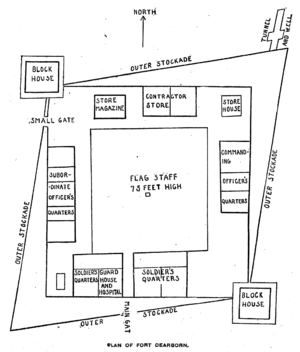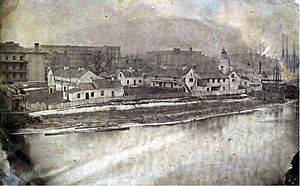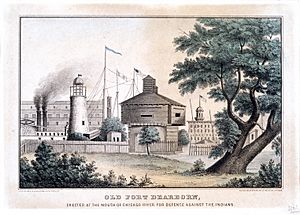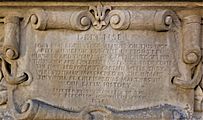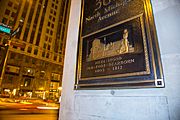Fort Dearborn facts for kids
Quick facts for kids |
|
|
Fort Dearborn
|
|
|
U.S. Historic district
Contributing property |
|

1856 drawing showing Fort Dearborn as it appeared in 1831
|
|
| Lua error in Module:Location_map at line 420: attempt to index field 'wikibase' (a nil value). | |
| Location | Chicago, Illinois |
|---|---|
| Architect | U.S. Army |
| Architectural style | log-built fort enclosed in a double stockade |
| Part of | American frontier, Michigan–Wacker Historic District (ID78001124) |
Fort Dearborn was an important United States fort built in 1803. It stood right next to the Chicago River, in what is now the big city of Chicago, Illinois. Soldiers led by Captain John Whistler built it. The fort was named to honor Henry Dearborn, who was the Secretary of War at the time.
The first fort was destroyed in 1812 during the War of 1812. A second fort was built on the same spot in 1816. By 1837, the fort was no longer needed by the army. Parts of it were taken down in 1855 to make the Chicago River wider. A fire in 1857 also destroyed some parts. The very last pieces of Fort Dearborn were lost in the Great Chicago Fire of 1871. Today, the place where the fort once stood is a special Chicago Landmark. You can find it in the Michigan–Wacker Historic District.
Contents
What Was Chicago Like Before the Fort?
Early Explorers and Native Americans
We don't know much about the Chicago area before Europeans arrived. In 1673, two explorers, Louis Jolliet and Jacques Marquette, were the first to write about crossing the Chicago Portage. This was a path that connected rivers, allowing them to travel along the Chicago River. Marquette came back in 1674 and camped near the river's mouth for a few days. He then moved to the portage and stayed there through the winter.
Joliet and Marquette didn't see any Native Americans living right by the Chicago River. However, archaeologists have found many old village sites from that time in other parts of the Chicago area. Later, in 1682, René Robert Cavelier, Sieur de La Salle claimed this large area for France.
Changes in Control of the Land
After the French and Indian War in 1763, France gave this land to Great Britain. It became part of the Province of Quebec. Great Britain later gave the area to the United States after the American Revolutionary War. But the British still controlled the Northwest Territory until about 1796.
After another conflict called the Northwest Indian War (1785–1795), a peace agreement was signed. This was the Treaty of Greenville in 1795. As part of this treaty, a group of Native American tribes gave large parts of modern-day Ohio, Michigan, Indiana, Wisconsin, and Illinois to the United States. This included "six square miles" around the mouth of the Chicago River.
Who Lived in Chicago Before the Fort?
A French-Jesuit mission was started near Chicago in 1696 but was abandoned around 1700. Wars with the Fox tribe made it hard for Europeans to live in the area for a while.
The first non-native person to settle there might have been a trader named Guillory around 1778. He may have had a trading post near Wolf Point on the Chicago River. Jean Baptiste Point du Sable built a farm and trading post in the 1780s. Many people consider him the founder of Chicago. Antoine Ouilmette was another early resident. He said he settled at the mouth of the Chicago River in 1790.
Building the First Fort Dearborn
On March 9, 1803, Henry Dearborn, the Secretary of War, sent a letter. He told Colonel Jean Hamtramck to send an officer and six men to explore the route from Detroit to Chicago. They also needed to check out the situation in Chicago.
Captain John Whistler was chosen to lead the new fort. He left with six men to do the survey. After the survey was done, a group of soldiers started their journey from Detroit to Chicago on July 14, 1803. Captain Whistler and his family traveled to Chicago on a ship called the Tracy.
The soldiers arrived on August 17. The Tracy had to anchor about half a mile offshore. It couldn't enter the Chicago River because of a sandbar at its mouth. Julia Whistler, the wife of Captain Whistler's son, later said that 2,000 Native Americans gathered to see the Tracy.
The soldiers finished building the fort by the summer of 1804. It was made of logs and had a double stockade fence around it. It also had two blockhouses for defense. The fort was named Fort Dearborn after Secretary of War Henry Dearborn.
Life at the Fort and a Conflict
A fur trader named John Kinzie arrived in Chicago in 1804. He bought the old property of Jean Baptiste Point du Sable. Kinzie quickly became the leader of the small group of civilians who lived around the fort.
In 1810, Kinzie and Captain Whistler had a disagreement. Whistler was concerned about Kinzie selling alcohol to Native Americans. In April, Whistler and other officers were removed from the fort. Captain Nathan Heald took over as the fort's commander.
The Battle of Fort Dearborn
During the War of 1812, General William Hull ordered everyone to leave Fort Dearborn in August 1812. Captain Heald was in charge of the evacuation. But on August 15, about 500 Potawatomi Native Americans attacked the group along the trail. This event is known as the Battle of Fort Dearborn.
The Potawatomi captured Captain Heald and his wife, Rebekah. They were later traded to the British. Out of 148 soldiers, women, and children leaving the fort, many were killed in the attack. The Potawatomi then burned the fort to the ground the next day.
The Second Fort Dearborn
After the war, a second Fort Dearborn was built in 1816. This new fort had a double wall of wooden palisades. It also had buildings for officers and soldiers, a garden, and other structures. American soldiers stayed at the fort until 1823. Peace with the Native Americans meant the fort was not needed as much then.
The fort was left empty for a while. But it was used again in 1828 after a war started with the Winnebago Native Americans. Juliette Kinzie, who arrived in Chicago in 1831, described the fort in her book:
The fort was inclosed [sic] by high pickets, with bastions at the alternate angles. Large gates opened to the north and south, and there were small portions here and there for the accommodation of the inmates. ... Beyond the parade-ground which extended south of the pickets, were the company gardens, well filled with currant-bushes and young fruit-trees. The fort stood at what might naturally be supposed to be the mouth of the river, yet it was not so, for in these days the latter took a turn, sweeping round the promontory on which the fort was built, towards the south, and joined the lake about half a mile below
The fort was briefly closed again before the Black Hawk War of 1832. By 1837, the fort was being used by the person in charge of harbor work. In 1837, the fort and its land were given to the city by the government. This land included part of what is now Grant Park.
In 1855, part of the fort was torn down. This was to make the Chicago River wider and straighter at that spot. In 1857, a fire destroyed almost all the remaining buildings. The last blockhouse and a few other buildings were destroyed in the Great Chicago Fire of 1871.
Fort Dearborn's Lasting Mark
The southern edge of Fort Dearborn was located where Wacker Drive and Michigan Avenue meet today. This is in the Loop area of Chicago. You can see where part of the fort was marked by plaques. There is also a line set into the sidewalk and road near the Michigan Avenue Bridge. A few wooden boards from the old fort are kept at the Chicago History Museum.
In 1899, the Chicago Tribune newspaper wrote about a copy of the original fort. This copy was made by the Chicago Historical Society.
In 1933, a detailed copy of Fort Dearborn was built for the Century of Progress Exhibition. This was a big fair. To celebrate, a special one-cent postage stamp and a souvenir sheet were made. They both showed the fort.
In 1939, the Chicago City Council added a fourth star to the city flag. This star represents Fort Dearborn. It is the first star on the left side of the flag.
The site of the fort was named a Chicago Landmark on September 15, 1971.
Images for kids
- Modern Commemorations
-
London Guarantee Building with a large relief above the entrance commemorating Fort Dearborn


